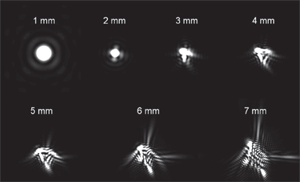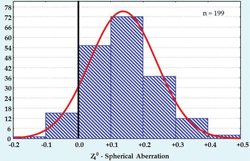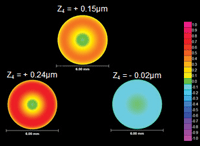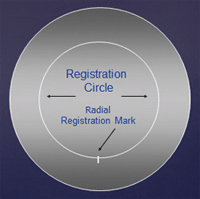Refractive surgery ushered in the first application in the ophthalmic profession of wavefront technology as a means of improving visual outcomes. Not long after, there were efforts in the optical industry to generate wavefront-guided spectacle lenses.
Wavefront refractions are made possible by a number of instruments that incorporate Hartmann-Shack aberrometry.

1. Point-spread functions with pupil size. Photo: Zeiss Vision
The iProfiler plus (Zeiss) includes specialized software to blend the objective wavefront refraction with the manifest subjective refraction as a means to balance the optical requirements for the full range of pupil sizes for the individual eye.
There is an opportunity to apply wavefront aberrometry data to contact lens fitting principles, in an effort to bring the contact lens visual acuity as close as possible to the best spectacle corrected visual acuity, in the same manner that the technology improved refractive surgery outcomes. Historically, the majority of contact lens wearers have been between 18 and 35 years of age.1
During this phase of life, the dynamic range of the pupil size is large. It is expected that contact lens wearers could benefit from greater attention to their higher-order aberrations (HOAs), since HOAs increase commensurate with pupil size (figure 1).
The First Step to Modulation
Studying HOA data from normal eyes reveals that the two most prevalent aberrations are vertical coma and spherical aberration (figure 2). Each of these, as well as the less prevalent aberrations, can be corrected with contact lenses.
Spherical aberration can easily be corrected by the selection of the eccentricity of one or both surfaces of either a rigid or soft contact lens, and can then be incorporated without concern for rotational stability of a spherical correction. The correction of vertical coma requires rotational stability, as coma has an axis and must be treated and prescribed in the same manner as a toric lens.

2. Spherical aberration in normal eyes.
Measuring residual HOAs with a contact lens in place is the key measurement for determining what will be the required correction. Let’s call this an “over-aberrometry,” in the same manner that we refer to a sphero-cylindrical over-refraction.
A first effort to use an existing aberrometer is to establish the practice of measuring HOAs on each existing contact lens wearer with their habitual lenses in place as part of their pre-testing. You should expect to find a number of patients with significant residual HOA.
Note that the focus is not on the anterior corneal aberrations or the total aberrations of the eye but the total aberrations of the lens-eye system.
With this information available, you’ll be aware of a few elements of your patient’s visual compromise even before they describe them to you.
For example, you will be able to tell the patient that they have difficulty seeing well at night when wearing their contact lenses. You will also be able to tell when a patient doesn’t see as well with one eye as the other when the measurements reveal higher vertical coma or trefoil in one eye.
These measurements, along with the case history, provide you the opportunity to make a contact lens recommendation that exceeds the performance of your patient’s habitual lenses. This step of differentiation may help to raise the appreciation your patients feel for you and your practice, which serves to enhance patient loyalty and referrals.
Contact Lens-induced HOAs
Kollbaum et al. reported the measure of both variable low- and higher-order aberrations as a result of on-eye contact lens deformation.2 Deformation-induced aberration is one variable that will lead to challenges in advanced wavefront-guided contact lenses.
This particular complication presents itself in the same manner as the variability in the biomechanical aspects of the healing limits of wavefront-guided refractive surgery.
Re-epithelializing and flap interface variance can have variation in micron height that is greater than the wavefront feature in the procedure. In the same manner, contact lens deformation can be of equivalent in magnitude to the HOA feature.
New design strategies to develop non-deforming soft lenses will help to advance wavefront-guided contact lenses by reducing the noise from these deformation-induced aberrations.
Hammer and colleagues reported a model for predicting the spherical aberration of contact lenses based on two factors: base curve and power.3 It is well understood that the spherical aberration induced by a contact lens will vary with the power, unless an effort is made to neutralize the effect by making at least one surface of the lens aspheric.
It is worth noting that doing so will only manage the induced spherical aberration of the lens. This technique will not attend to the spherical aberration of the eye itself or the induced aberrations from lens deformation. This realization helped to set the stage for the practice of what I call “wavefront lite.”
Wavefront Lite
Each manufacturer designs its lenses for a resultant intended or unintended amount of spherical aberration. These values are not reported as part of normal labeling and, in some cases, may not be known by the manufacturer.
As a result, the eye care practitioner cannot easily make a prospective decision on a particular brand based solely on the known aberrations of the respective lenses. Even so, the aberrometer can be used to measure the lens/eye aberrations of any lens on any eye.

3. Spherical aberration in three brands of lenses having the same lens power.
One strategy to consider is modifying your contact lens evaluation to include the application of three or more brands of lenses in the same power, along with the measurement of the residual lens eye aberrations of each lens on eye.
Figure 3 demonstrates the difference in spherical aberration of three different brands of contact lenses with the same power. Consider that each brand may manifest a different spherical aberration.
For example, one brand may have neutral spherical aberration while another may have positive spherical aberration and yet another may have negative spherical aberration. In a case such as this, they cannot all be optimum for a single eye; however, they all may be optimum for some eyes.
Wavefront Lite is the practice of using your existing aberrometer to select a lens that produces residual aberrations that are in the best interest of the patient. The desired pattern residual spherical aberration you prescribe may be a function of a patient’s age, pupil size range, and refractive error.
For example, negative spherical aberration is understood as a risk factor for young children and those progressing in myopia.4 In this case, a higher positive spherical aberration may be your prescription of choice.
In the case of a young adult patient with stable myopia and a measurement of large mesopic pupil size that reports a high frequency of night driving, low or no spherical aberration may be your recommendation.
Positive spherical aberration is expected to cause reduced contrast sensitivity and visual acuity at night and with a dilated pupil. This is the case even when the lens power is accurate for a smaller pupil size.5
Wavefront Lite could aid you in finding the brand of lens in the correct power that most closely demonstrates your intended spherical aberration correction.
The Future
Vicoh, LLC—of which I am a cofounder—has developed contact lens cutting files for independent laboratories to manufacture lenses of the same power with a series of spherical aberration values.6 In this manner, the eye care practitioner may select the preferred spherical aberration value from diagnostic lenses having the respective values and by use of an over-aberrometry.
The lenses are manufactured using a non-deforming lens design achieved by fitting the base curve of the soft lens much closer to the keratometry measurement than conventional soft lenses. The periphery of the lens is used to control the fit instead of the base curve.7
Wavefront Advanced
The process of measuring and manufacturing custom lenses that correct the individual aberrations of each eye has been in development for some time. WaveForm (Kalispell, MT) is a company currently pursuing this goal.8
One method that was defined by Magnante includes the placement of a diagnostic lens with a known aberration pattern and measuring the aberrometry of the lens-eye system. Then, a customized lens is ordered using the known diagnostic lens values and the over-aberrometry. An individual cutting file is generated for each lens, which is then used to manufacture the custom or personal wavefront lens.8

4. Registration mark.
The custom lens must demonstrate orientation consistency each time it is placed. Orientation stability, both rotationally and translationally, must also be achieved.
Translational movement of a modern soft lens is low enough to not interfere with the spherical aberration component for eyes in the normal range (those without irregular astigmatism or post-surgical complication).
The lens needs to be free from any on-eye deformation, and must demonstrate a stable pre-lens tear film. The process also requires a precision registration mark on the lens and the ability to capture an image of both the registration mark and the pupil (figure 4).
It is also worth noting that the image capture process must be free of head tilt.
Patients with significant corneal irregularity from keratoconus, penetrating keratoplasty, corneal trauma or refractive surgery complications will benefit greatly from successful Wavefront Advanced contact lens prescriptions.
These conditions commonly manifest significant concomitant irregular astigmatism, which is more accurately labeled higher order aberrations.
WaveForm is also targeting the correction of presbyopia in an effort to reduce the HOAs that complicate the achievement of good distance and near vision with simultaneous vision correction.
Manufacturing Metrology to Match Clinical Measurements
The limited ability to measure what is prescribed and manufactured is a historical reality in the ophthalmic field. Today, wavefront lensometers, or contact lens aberrometers, are available to measure the sub-micron features that are diamond turned to produce a higher order aberration correction contact lens.
The systems are currently in place to produce the Wavefront Lite and the Wavefront Advanced contact lenses. Eye care practitioners can use this technology to practice a new level of vision correction and harness the diagnostic potential of their current aberrometers in the contact lens practice.
Dr. Legerton is an author, lecturer,
inventor and consultant to the ophthalmic industry. He is a cofounder of
SynergEyes and Innovega, and has 32 issued US patents for contact lens
technology including SynergEyes, Paragon CRT, myopia progression
control, presbyopic laser refractive surgery and novel multifocal
contact lenses.
1.Swanson MW. A cross-sectional analysis of U.S. contact lens user demographics. Optom Vis Sci. 2012 Jun;89(6):839-48. doi: 10.1097/OPX.0b013e318255da45.
2.Kollbaum, PS. Comparing the optical properties of soft contact lenses on and off the eye, Optom Vis Sci. 2013 Sept; 90(9):924-936.
3.Hammer RM, Spherical aberration of Aspheric Contact Lenses on Eye. Optom Vis Science. 1994 71(8):522-528.
4.Charman WN. Aberrations and myopia. Ophthalmic Physiol Opt. 2005 July:25(4):285-301.
5.Li J, et, al. Effects of spherical aberration on visual acuity at different contrasts. J Cataract Refract Surg. 2009. Aug;35(8):1389-95. doi: 10.1016/j.jcrs.2009.03.033.
6.Legerton JA. US patent 8,430,511, Kit of higher order aberration contact lenses and methods of use.
7.Legerton JA. US patent 8,388,130, Non-deforming contact lens.
8.http://www.waveformlenses.com/index.html accessed November 1, 2013.
9.Magnante PC. US Patent 6,086,204 Methods and devices to design and fabricate surfaces on contact lenses and on corneal tissue that correct the eye's optical aberrations.


